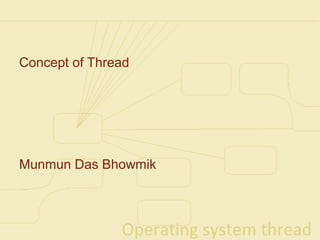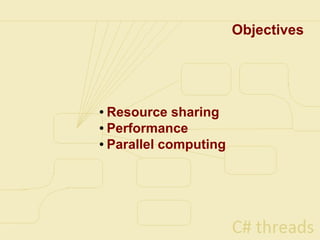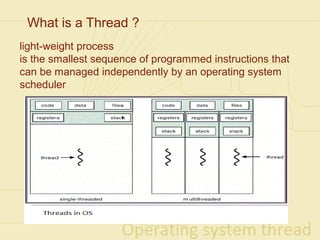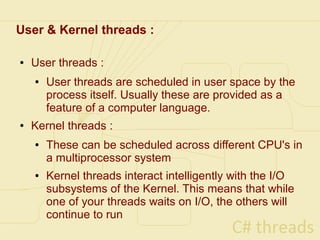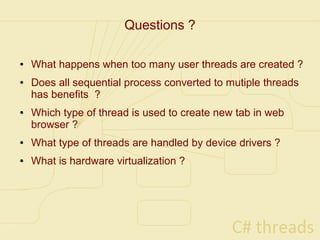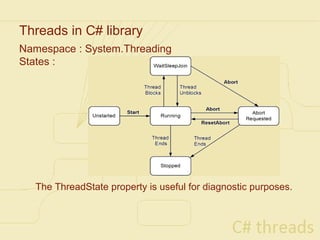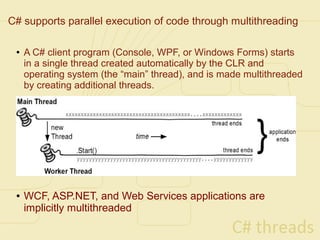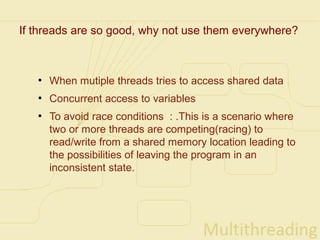Concept of thread
- 1. Concept of Thread Munmun Das Bhowmik
- 2. Objectives â Resource sharing â Performance â Parallel computing
- 3. Few terms to be used : â Processor : runs a code stream â Function : a particular code stream â Schedule : time slice given by processor â Process : instance of a program being executed â Registers : physical storage of CPU â Kernel : interface between hardware & software â Thread : an execution context for processor â Thread context : The register set, stacks & private storage area are known as context of thread.
- 4. What is a Thread ? light-weight process is the smallest sequence of programmed instructions that can be managed independently by an operating system scheduler
- 5. Benefits : âĒ Resourse sharing : On a single-processor machine, the operating system is switching rapidly between the threads, giving the appearance of simultaneous execution. âĒ Responsiveness : Maintain a responsive user interface while background tasks are executing âĒ Distinguish tasks of varying priority âĒ Economy : Perform operations that consume a large amount of time without stopping the rest of the application.
- 6. âĒ Another example is a web server - Multiple threads allow for multiple requests to be satisfied simultaneously, without having to service requests sequentially or to fork off separate processes for every incoming request. ( The latter is how this sort of thing was done before the concept of threads was developed. A daemon would listen at a port, fork off a child for every incoming request to be processed, and then go back to listening to the port. )
- 7. User & Kernel threads : â User threads : â User threads are scheduled in user space by the process itself. Usually these are provided as a feature of a computer language. â Kernel threads : â These can be scheduled across different CPU's in a multiprocessor system â Kernel threads interact intelligently with the I/O subsystems of the Kernel. This means that while one of your threads waits on I/O, the others will continue to run
- 8. Models : User thread(N:1) : Kernel thread (1:1): Hybrid (M:N) : user library â N number of application â â simplest possible no kernel threads onto some M number â threading implementation modifications of kernel entities, or "virtual â scheduling/ processors." flexible & low cost synchronization â thread may block â are more complex to coordination implement than either kernel entire process, no parallelism â less overhead than or user threads, because â Eg : Win 32 process, suitable for changes to both kernel and parallel application user-space code are required â Eg : Windows 7
- 9. Questions ? â What happens when too many user threads are created ? â Does all sequential process converted to mutiple threads has benefits ? â Which type of thread is used to create new tab in web browser ? â What type of threads are handled by device drivers ? â What is hardware virtualization ?
- 10. Threads in C# library Namespace : System.Threading States : The ThreadState property is useful for diagnostic purposes.
- 11. C# supports parallel execution of code through multithreading â A C# client program (Console, WPF, or Windows Forms) starts in a single thread created automatically by the CLR and operating system (the âmainâ thread), and is made multithreaded by creating additional threads. â WCF, ASP.NET, and Web Services applications are implicitly multithreaded
- 12. If threads are so good, why not use them everywhere? â When mutiple threads tries to access shared data â Concurrent access to variables â To avoid race conditions : .This is a scenario where two or more threads are competing(racing) to read/write from a shared memory location leading to the possibilities of leaving the program in an inconsistent state.
- 13. Synchronization Block methods : Sleep , Wait, Task.Wait Lock Constructs : Construct Purpose Cross process Lock(Monitor.Enter/ only one thread can access a resource - Monitor.Exit) or enter the critical zone Mutex yes SemaphoreSlim (.Net 4.0) Not more than a specified number of - threads can access a resource or enter Semaphore the critical zone yes ReaderWriterLockSlim (.Net Allows multiple readers to coexist - 3.5) with a single writer ReaderWriterLock -
- 14. Protecting shared data in safer way â Thread â safety concept : wait() T1 Shared data T2 Exclusive T3 Sleep() lock While waiting on a Sleep or Join, a thread is blocked and so does not consume CPU resources.
- 15. Points to consider while designing Threading has resource requirements & potential conflicts. â Few threads should be used as it will minimize the operating system resources & improving performance. â Memory consumed for context those required by AppDomain objects , processes & threads. â Consumes processor time. If most of current threads are in one process, then other threads processes are scheduled less frequently. â Thread pooling / thread spawning â Shared access to resources creates conflicts. â Failure to synchronize causes deadlocks or race conditions.
- 16. Questions : â Benefits of thread pooling ? â How to handle long running threads ? â What about the performance ? â What is the mechanism for Worker thread ? â Different ways to create muti-threaded applications in .Net ? â Explicit thread class , task parallel library , lambda functions , BeginInvoke , BackgroundWorker
- 17. Thank you !

